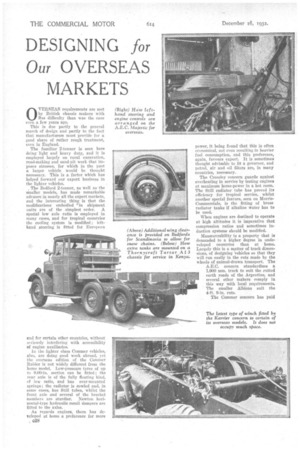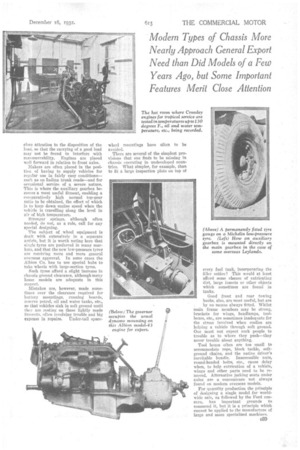DESIGNING for Our OVERSEAS
Page 84

Page 85

If you've noticed an error in this article please click here to report it so we can fix it.
MARKETS
OVERSEAS requirements are met by British chassis makers with Itss difficulty than was the case even a few years ago. This is due partly to the general march of design and partly to the fact that manufactuirens must provide for a good share of rather rough treatment, even in Englund.
The familiar 2-tonner is seen here doing light and heavy duty, and it is employed largely on rural excavation, road-making and sand-pit work that imposes stresses, for which in the past a larger vehicle would be thought necessary. This is a factor which has helped forward our export business in the lighter vehicles.
. The Bedford 2-tonner, as well as the smaller models, has made remarkable advance in nearly all the export markets, and the interesting thing is that the modifications embodied 9n shipment units are of the simplest order. A special low axle ratio is employed in many cases, and for tropical countries the cooling system is modified ; lefthand steering is fitted for European and for certain other countries, without seriously interfering with accessibility of engine auxiliaries.
In the lighter class Commer vehicles, also, are doing good work abroad, yet the overseas edition of the Commer Raider is not widely different from the home model. Low-pressure tyres of up to 9.00-in. section can be fitted ; the rear axle is of the fully floating kind, of low natio, and has over-mounted springs; the radiator is cowled and, in some cases, -has Still tubes, whilst the front axle and several of the bracket members are sturdier. Newton horizontal-type hydraulic recoil dampers are fitted to the axles.
As regards engines, there has developed at home a preference for more , c438 power, it being found that this is often economical, not even resulting in heavier fuel consumption, and this preference, again, favours export. It is sometimes thought advisable to fit a governor, and petrol,' air and oil filters are, in many countries, necessary.
The Crossley concern guards against overheating in service by testing engines at maximum horse-power in a hot room. The Still radiator tube has proved its efficiency for tropical service, whilst another special feature, seen on MorrisCommercials, is the fitting of brass radiator tanks if alkaline water has to be used.
When engines are destined to operate at high altitudes it is imperative that compression ratios and sometimes induction systems should be modified.
Manceuvrability ia a property that is demanded to a higher degree in undeveloped countries than at home. Largely this is a matter of track dimensions, of designing vehicles so that they will run easily in the ruts made by the wheels of animal-drawn transport. The A.E.C. concern standardizes a 1,600 mm. track to suit the rutted earth roads of the Argentine, and several other makers comply in this way with local requirements. Phe smaller Albions suit the 4-ft. 9-in. ruts.
The Comrner concern has paid close attention to the disposition of the load, so that the carrying of a good load may not be found to interfere with manteuvrability. Engines are placed well forward in relation to front axles.
Makers are often placed in the position of having to supply vehicles for regular use in fairly easy conditions— such as on Indian trunk roads—and for occasional service of a severe nature. This is where the auxiliary gearbox becomes a most useful fitment, enabling a comparatively high normal top-gear ratio to be obtained, the effect of which is to keep down engine speed when the vehicle is travelling along the level in air of high temperature.
Stronger springs, although often needed, do not, as a rule, call for any special designing.
The subject of wheel equipment is dealt with extensively in a separate article, but it is worth noting here that single tyres are preferred in man* markets, and that the new low-pressure tyres are receiving more and more general overseas approval. In some cases the Albion Co. has to use special hubs to take wheels with large-section tyres.
Such tyres afford a slight increase in chassis ground clearance, although many home models are adequate in this respect.
Mistakes are, however, made sometimes over the clearance required for battery mountings, running boards., reserve petrol, oil and water tanks, etc., so that vehicles sink in soft ground until they are resting on these lightly made fitments. often involving trouble and big expense in repairs. Under-tail spare wheel mountings have often to be avoided.
There are several of the simplest provisions that one finds to be missing in chassis operating in undeveloped countries. What simpler, for example, than to fit a large inspection plate on top of every fuel tank, incorporating the filler orifice? This would at least afford some chance of extricating dirt, large insects or other objects which sometimes are found in tanks.
Good front and roar towing hooks, also, are most usefril, but are by no means always fitted. Whilst main frame members may be strong, brackets for wings, headlamps, toolboxes, etc., are sometimes inadequate for the stress involved when coolies are helping a vehicle through soft ground. One must not expect such people to trouble as to where they push—they never trouble about anything.
Tool boxes often are too small to accommodate rope, block tackle, softground chains, and the native driver's inevitable bundle. Inaccessible nuts, round-headed bolts, etc., cause delay when, to help extrication of a vehicle, wings and other parts need to be removed. Alternative jacking seats under axles are a convenience not always found on modern overseas models.
For quantity production the principle of designing a single model for worldwide sale, as followed by the Ford concern, has important grounds to commend it, but it is a principle which cannot he applied to the manufacture of large and more specialized machines,




























































































































































